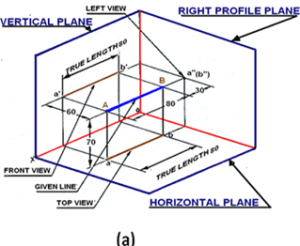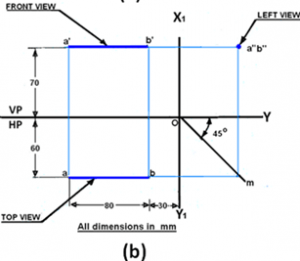This set of Civil Engineering Drawing Multiple Choice Questions & Answers (MCQs) focuses on “Projection of Straight Lines”.
1. A straight line is the ___________ distance between two points.
a) shortest
b) longest
c) half
d) infinite
View Answer
Explanation: As we know lines are formed by points and shortest line which can be formed is the straight line between two points. Hence, the projections of a straight line may be drawn by joining the respective projections of its ends which are points.
2. A line is a geometric primitive that has no ____________
a) length
b) point
c) direction
d) thickness
View Answer
Explanation: A point has no length or width. It has no thickness. Point is a mark of position. A point specifies the exact location. Point is denoted by a dot (.) and is named by an alphabet. Line is composed of infinite points and so here it can be said that a line also does not have thickness.
3. A line may not be __________
a) parallel to both the planes
b) parallel to one plane and perpendicular to the other
c) parallel to one plane and inclined to the other
d) perpendicular to both the planes
View Answer
Explanation: The question is asking about a single line and if a line is perpendicular to both the planes it will never be resembled as a line i.e. it can’t be a single line. If it becomes perpendicular to the planes it will become perpendicular to itself thus forming two lines, as the single to will itself make 90 angle it can’t be further called as a single line.
4. When a line is parallel to a plane, the projection of the line on to that plane will be its ______ length.
a) shortened
b) true
c) enlarged
d) point
View Answer
Explanation: The projection of line AB lying parallel to the Vertical plane (VP) is shown in figure below as a’b’, representing the true length.
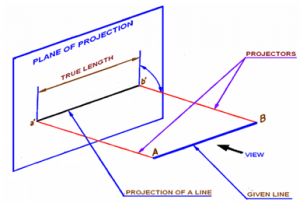
5. When a line is parallel to one plane and inclined to the other, the projection of the line on the plane to which it is parallel will show its __________ length.
a) shortened
b) true
c) enlarged
d) false
View Answer
Explanation: The projected length on the plane to which it is inclined will always be shorter than the true length. In figure 2, the line AB is parallel to VP and is inclined to HP. The angle of inclination of AB with HP is being θ degrees. Projection of line AB on VP is a’b’ and is the true length of AB. The projection of line AB on HP is indicated as line ab. Length ab is shorter than the true length AB of the line. Refer the figure below.
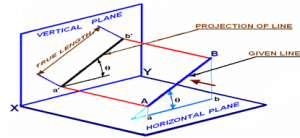
6. When the Projection of a line is parallel to both HP and VP its length will be _______
a) shortened
b) false
c) enlarged
d) true
View Answer
Explanation: Since the line is parallel to both HP and VP, both the front view a’b’ and the top view ab are in true lengths. Since the line is perpendicular to the right PP, the left side view of the line will be a point a΄΄(b΄΄). After projection on to the projection planes, the planes are rotated such that all the three projection planes lie in the same planes. The multi-view drawing of line AB is shown in figure b.
7. In a case when a line is perpendicular to HP & parallel to VP then what figure will be projected on HP?
a) Point
b) Line
c) Square
d) Inclined line
View Answer
Explanation: Draw the horizontal projector through a(b) to cut the 45 degree line at m. Draw the horizontal projectors through a’ and b’ to intersect the vertical projector drawn through m at a΄΄ and b΄΄. a΄΄b΄΄ is the left view of the line AB.
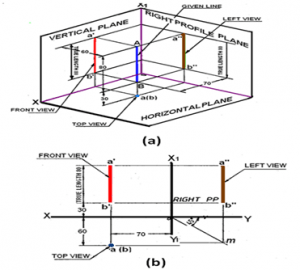
8. A line AB, 90 mm long is inclined at 30° to HP and parallel to VP. The line is 80 mm in front of VP. The lower end A is 30 mm above HP. The upper end B is 50 mm in front of the right PP. The right profile plane will show a _________ projection.
a) point
b) small
c) true
d) false
View Answer
Explanation: The projections of line AB shown in figure 5 can be obtained in the following manner. Mark a’, the front view of the end A, 30 mm above HP. Draw the front view a΄b΄ = 90 mm inclined at 30° to XY line.
Project the top view ab parallel to XY line. The top view is 80 mm in front of VP. Draw the X1Y1 line at a distance of 50 mm from b’. Draw a 45° line through O. Draw the horizontal projector through the top view ab to cut the 45 ° line at m. Draw a vertical projector through m. Draw the horizontal projectors through a’ and b’ to intersect the vertical projector drawn through m at a” and b”. Connect a΄΄ b΄΄ which is the left side view.
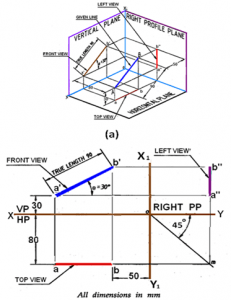
9. If the apparent and the true inclinations of a line with HP are equal, the line is ____________
a) parallel to horizontal plane
b) parallel to vertical plane
c) parallel to profile plane
d) inclined to both reference plane
View Answer
Explanation: When the line is parallel to the vertical plane and perpendicular to HP then it will form a point projection on the HP and so the apparent and the true inclination will be same of the line as it will resemble a point projection.
10. If the front view of a line is parallel to the xy line, its perpendicular length can be ___________
a) front view
b) top view
c) side view
d) no front view
View Answer
Explanation: Since in both these cases line will be parallel to both the planes and so no perpendicular will fall on any of them hence neither top nor front views will be formed.
11. The point at which the line intersects the VP, extended if necessary, is known as ____________
a) profile trace
b) horizontal trace
c) vertical trace
d) auxiliary trace
View Answer
Explanation: If a line is parallel to any of the plane, it has no trace upon that plane. For example: If the line is parallel to horizontal plane then that line will not meet H.P and hence there will be no Horizontal Trace and only Vertical Trace.
12. If top view of a line is a point, its front view is ____________
a) parallel to xy line and of true length
b) parallel to xy line and of apparent length
c) perpendicular to xy line and of true length
d) perpendicular to xy line and of apparent length
View Answer
Explanation: When the line is parallel to the vertical plane and perpendicular to HP then it will form a point projection on the HP and so the apparent and the true inclination will be same of the line as it will resemble a point projection.
Sanfoundry Global Education & Learning Series – Civil Engineering Drawing.
To practice all areas of Civil Engineering Drawing, here is complete set of 1000+ Multiple Choice Questions and Answers.
If you find a mistake in question / option / answer, kindly take a screenshot and email to [email protected]
- Check Civil Engineering Drawing Books
- Practice Civil Engineering MCQs
- Apply for Civil Engineering Internship
- Check Civil Engineering Books
